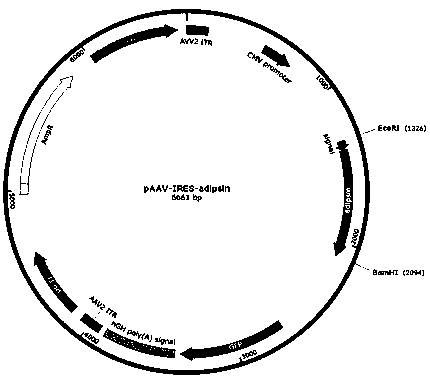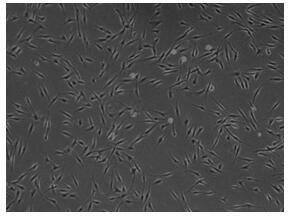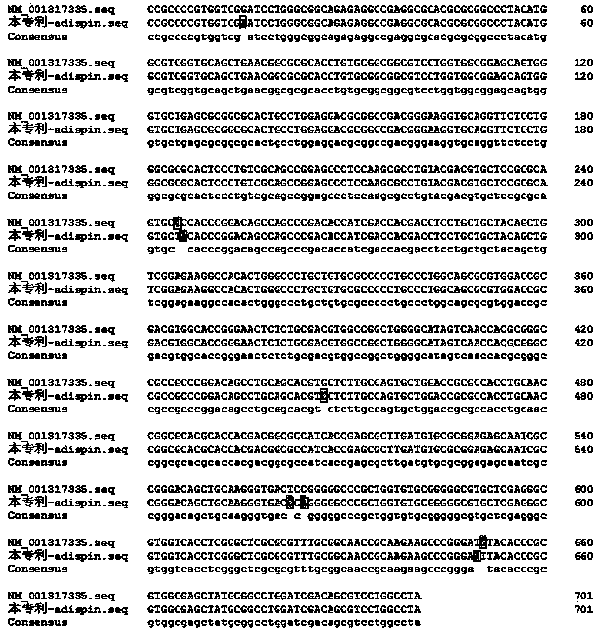Adipsin gene modified adipose-derived stem cells as well as preparation method and application thereof
An adipose stem cell, gene modification technology, applied in genetically modified cells, cells modified by introducing foreign genetic material, and botanical equipment and methods, etc. It can improve the vitality and increase the secretion of insulin.
- Summary
- Abstract
- Description
- Claims
- Application Information
AI Technical Summary
Problems solved by technology
Method used
Image
Examples
Embodiment 1
[0047] Embodiment 1: Containing the construction of adipsin gene expression vector
[0048] The fusion gene for modifying fat stem cells, including signal nucleic acid artificial sequence (SEQ ID NO.1) and adipsin nucleic acid artificial sequence (SEQ ID NO.2), respectively commissioned according to the nucleic acid coding sequences of SEQ ID NO.1 and SEQ ID NO.2 Sangon Bioengineering (Shanghai) Co., Ltd. synthesized the entire expression cassette and inserted it into the BamHI-EcoRI site of the adenovirus expression vector pAAV-IRES-ZsGreen1 (SEQ ID NO.3) (see attached figure 1 ), transformed into E.coli (DH5α), after the correct sequencing, the plasmid was extracted and purified using Invitrogen’s plasmid purification kit to obtain a high-quality plasmid of the recombinant expression vector.
[0049] In more detail, the preparation method provided in this embodiment includes the following steps:
[0050] The nucleic acid artificial sequence of the fusion gene adipsin was e...
Embodiment 2
[0054] Example 2: Preparation of fat stem cells
[0055] Adipose tissue was extracted from the abdomen of volunteers, washed with PBS solution under aseptic conditions to remove red blood cells, cut into fine particles with a scalpel, added trypsin and collagenase (v / v 1:1), and collected liquid after shaking and digesting, 1500rpm / 10min, resuspend the sediment in the medium, filter through a 200 mesh fine sieve, 1500rpm / 10min, resuspend the obtained cell extract with 10% FBS+DMEM culture medium, and place at 37°C, 5% CO 2 Cultured in the incubator, after 5 days, the medium was changed for the first time. Afterwards, the medium was changed every 3 days. When the confluence of the primary cells was 80%, they were digested and passed on to the P3 generation for subsequent experiments. Cell growth and morphology were observed under an optical microscope (see figure 2 ). The flow cytometer surface markers were detected on the P3 generation human adipose stem cells, and the cel...
Embodiment 3
[0056] Example 3: Adenovirus packaging and titer detection
[0057] (1) Recovery of 293T cells
[0058] 1) Take out the frozen 293T cells from the liquid nitrogen tank, quickly throw them into a 37°C water bath and shake them quickly until the cell solution is completely dissolved.
[0059] 2) Transfer the cell solution to a 50mL centrifuge tube, add 10 mL fresh complete medium to it, mix well and centrifuge at 1500 rpm for 5 min.
[0060] 3) Remove the supernatant, add 3 mL of fresh DMEM medium to resuspend the cells, transfer them evenly to a six-well plate, and make up 3 mL of medium in each well.
[0061] 4) Put the six-well plate in 37 ℃, 5%CO steadily 2 and cultured in an incubator with 95% relative humidity.
[0062] 5) Observe the cell survival rate the next day and replace with fresh medium. Afterwards, the growth of the cells was observed every day. When the cells covered the bottom of the well, they were subcultured, and were used for experiments when they cove...
PUM
 Login to View More
Login to View More Abstract
Description
Claims
Application Information
 Login to View More
Login to View More - R&D
- Intellectual Property
- Life Sciences
- Materials
- Tech Scout
- Unparalleled Data Quality
- Higher Quality Content
- 60% Fewer Hallucinations
Browse by: Latest US Patents, China's latest patents, Technical Efficacy Thesaurus, Application Domain, Technology Topic, Popular Technical Reports.
© 2025 PatSnap. All rights reserved.Legal|Privacy policy|Modern Slavery Act Transparency Statement|Sitemap|About US| Contact US: help@patsnap.com



